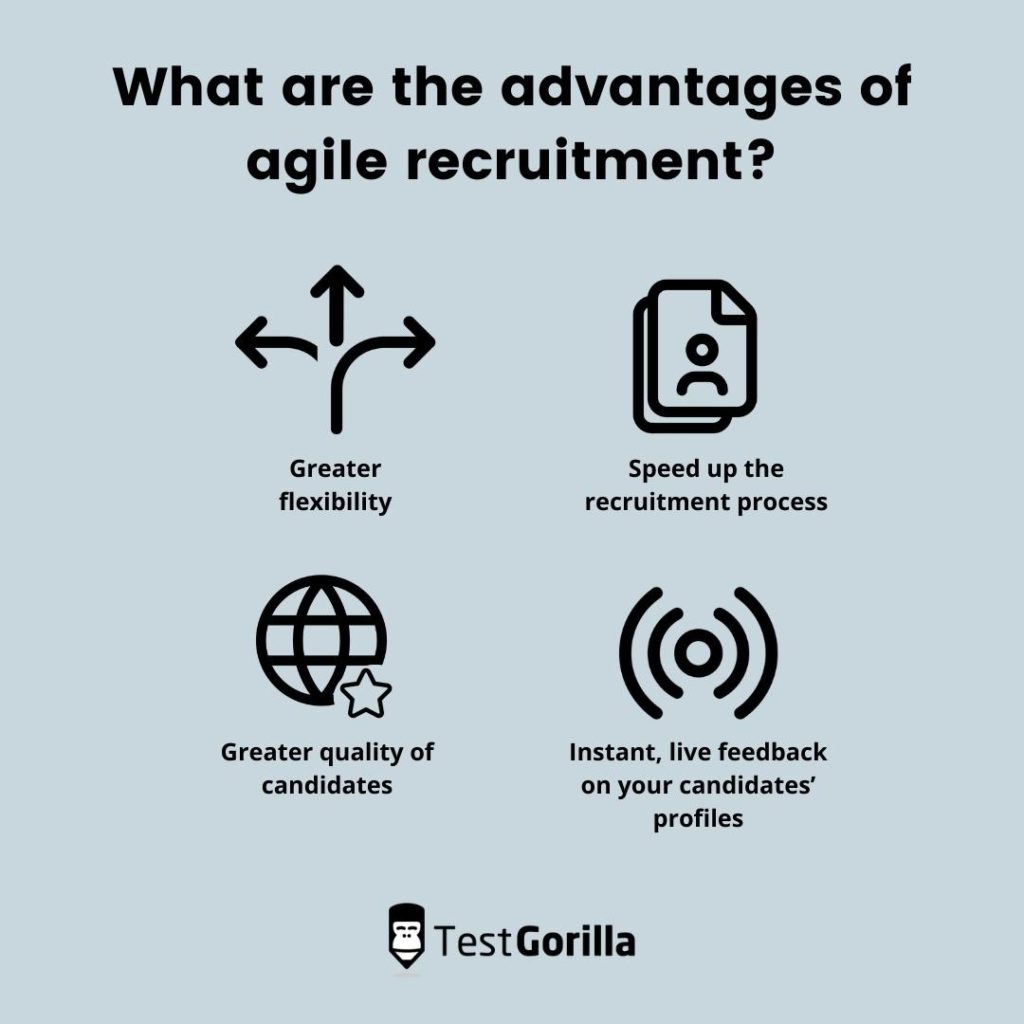Are you looking for ways to develop your recruitment strategy as a technical recruiter?
Have you encountered challenges in enhancing the experience of candidates who are applying for technical roles?
You’ll significantly benefit from an agile recruitment strategy!
This article will walk you through four simple steps for using an agile approach when hiring tech candidates for your team.
Take a look to find out what those four steps are and the primary benefits of agile recruitment.
Table of contents
What is agile recruiting?
Agile recruiting is a recruitment method used in technical recruitment to hire tech talent such as software engineers and developers. Creating a talent pipeline and employing technical professionals employs agile methods to simplify the hiring process.
What is an agile methodology?
The agile methodology is a software development strategy and management approach used in software development. It serves as a strategy to emphasize and facilitate team collaboration and encourage frequent product releases. Recruitment teams have successfully adopted this methodology.
If you’re a technical recruiter, you’ve probably heard of sprints in agile methodology. However, if you’re new to technical recruitment, sprints refer to the bite-size sections that the development process is divided into.
There are several different examples of agile methodology, including:
Scrum
Lean software development
Adaptive software development
Dynamic systems development method
The concept of agile recruiting has been derived from the Agile Manifesto for Software Development created in 2001.
In essence, agile recruiting adopts the concept of communicating as a team, offering feedback, adapting and responding to changes, and producing excellent results as part of the recruitment process.
What are the advantages of agile recruitment?
Four advantages of agile recruitment you should be aware of include increased flexibility when adjusting or regulating the workflow, a speedier recruitment process, higher applicant quality, and the ability to provide instant, real-time feedback to candidates.
1. Greater flexibility
Since agile recruiting makes it easier to manage recruiting objectives and projects, it also allows you to prioritize your goals more flexibly and communicate with the recruiting scrum team of HR experts with frequent feedback checkpoints to achieve those goals.
2. Speed up the recruitment process
Although 70% of companies take 1-4 months to process new hires, employing an agile recruiting method ensures that you spend your time efficiently during the recruitment cycle and optimize it.
As a result, an agile recruitment method can help you speed up the recruitment process by:
Ensuring you focus entirely on the most suitable talent (and avoid focusing on unqualified talent)
Breaking down your recruiting process into stages provides you with milestones and a timeline to achieve your recruitment objectives
Helping you manage the recruiting workflow more efficiently
3. Greater quality of candidates
Because agile recruitment shortens the time it takes to hire, you’re less likely to lose top talent to a competitor due to lengthy recruiting. This guarantees that the quality of your hires improves and that you hire the right candidates.
4. Instant, live feedback on your candidates’ profiles
By facilitating communication with hiring managers frequently, agile recruiting allows you to acquire fast, timely feedback on your candidates’ applications. This is critical for both your organization and your candidates for two reasons:
When you provide feedback to your candidates, you improve candidate experience
Your organization’s reputation will increase, and as a result, so will your brand
How can you implement an agile recruitment process?
Assembling your team, setting up smaller jobs by breaking down significant team member projects, scheduling frequent meetings, and developing an online presence for your business are the four stages you may take to create an agile recruiting process.
1. Assemble a team
If you’re employing a scrum agile recruiting strategy, you’ll need to assemble a small team since scrums work better in smaller groups.
Your team may comprise your recruitment team, the scrum master, and the product owner, and each team member should understand their responsibilities.
For instance, the scrum master improves communication between recruiting and developer teams while increasing their team’s performance level.
The recruiter team may include cross-functional team members with technical expertise to fulfill the recruitment goals of the organization.
What is the ideal size for an agile team?
Stick to a team size of a minimum of three people and a maximum of nine people. This is the ideal range because communication within the recruitment team becomes difficult with more than nine employees. With less than three people, your team might struggle to meet your recruitment goals.
2. Plan towards setting up smaller tasks from larger projects
To make it easier to meet recruitment goals, break down large projects into smaller tasks. Then, create milestones, prioritize them, and assign your team a certain number of weeks in a sprint cycle to complete these objectives.
To enhance the strategy, objectives and timelines for agile recruiting and milestone target setting should be adjusted and refined as per key performance indicators and recruitment metrics.
3. Arrange meetings to share feedback
Ensure that all team members are up-to-date on the status of ongoing recruitment tasks with team meetings. Again, efficient communication is essential for this; not only will you need to hold regular meetings (perhaps daily), but you’ll also need to make sure all team members are heard within those sessions.
Agile recruitment team meetings can use the same status updates as agile software development team meetings. They’re brief meetings in which you’ll ask your team questions to encourage transparency and frequent updates, like:
Which of your goals did you accomplish yesterday?
What goals are you working on today?
Are there any expected delays for your tasks/goals today?
4. Establish an online presence for your organization
As part of your agile recruiting strategy, this is an intelligent method to attract a diverse pool of skilled applicants, both active and passive.
According to Software Suggest, your online presence should communicate to the world that your company is a fun place to work, and you could achieve this by hiring the services of a digital marketing agency.
According to Software Suggest, with the correct level of activity on a company’s social media profile, such as LinkedIn, an organization can promote their vacancy via these channels and sit back while getting flooded with interested candidates.
Essential agile recruiting tips to make the process effortless
Although establishing an agile recruiting strategy can be challenging, there are four points you should keep in mind to make it easier: use sprints and key performance indicators to measure and track your progress.
1. Use “sprints” when creating your agile recruiting strategy
A recruiting sprint is often a week-long period during which you focus on a particular stage of the recruitment process. Sprints are an effective method to adopt an agile recruitment strategy since they let you structure each week into recruitment goals.
You might set up your recruitment goals in 4 or 5-week sprint cycles. Here’s an example of a “sprint” cycle approach in agile recruitment for talent acquisition:
Focus on candidate sourcing in the first week
Carry out initial phone screening in the second week
Request candidates to complete skills assessments in the third week – which might include technical skills tests, coding questions, and custom coding response questions
Conduct interviews in the fourth week
2. Use key performance indicators to track agile recruitment efforts
Key performance indicators (KPIs) are essential metrics for determining the effectiveness of your agile recruitment. Some of the crucial key performance indicators you should employ include:
Source of hires
Time to hire
Cost per hire
Total number of candidates interviewed in comparison to the number of employment offers extended
The percentage of candidates who accept your job offer
3. Review the metrics required to evaluate your efforts
Because metrics are so important for implementing an agile recruitment strategy, assess the metrics and evaluate your HR team’s performance at the end of your sprint cycle.
Select a method for sharing these recruitment metrics with your team. For example, you might choose to send an email with a progress report, display the data in a presentation, or update your team using a spreadsheet.
According to a Yello report, 50% of teams who share recruiting analytics do so at least once a week.
4. Use a Kanban board to track your efforts visually
Kanban boards are an excellent method to visualize the progress of your recruitment operations. A digital Kanban board is ideal for this because:
Every in-office member of the team can view the progress on the board
Remote employees also have easy access and visibility of the board as well
Kanban boards help boost the productivity and efficiency of teams in their hiring projects
With a Kanban board, task prioritization and meeting deadlines are made straightforward and effective
Implement an agile recruitment approach and hire the right talent
An agile recruiting strategy is a unique approach to finding the perfect people for your organization. Remember, to put this approach into action, you must:
Identify and monitor metrics and key performance indicators
Use sprints in your strategy to break down larger projects
Ensure your team size is the right size for the job
TestGorilla’s pre-employment skills tests are the perfect addition to your agile recruitment approach and help make the right choice the first time around. Get started for free today and start making better hiring decisions, faster and bias-free.
Related posts
Hire the best candidates with TestGorilla
Create pre-employment assessments in minutes to screen candidates, save time, and hire the best talent.
Latest posts
The best advice in pre-employment testing, in your inbox.
No spam. Unsubscribe at any time.

Hire the best. No bias. No stress.
Our screening tests identify the best candidates and make your hiring decisions faster, easier, and bias-free.
Free resources
This checklist covers key features you should look for when choosing a skills testing platform
This resource will help you develop an onboarding checklist for new hires.
How to assess your candidates' attention to detail.
Learn how to get human resources certified through HRCI or SHRM.
Learn how you can improve the level of talent at your company.
Learn how CapitalT reduced hiring bias with online skills assessments.
Learn how to make the resume process more efficient and more effective.
Improve your hiring strategy with these 7 critical recruitment metrics.
Learn how Sukhi decreased time spent reviewing resumes by 83%!
Hire more efficiently with these hacks that 99% of recruiters aren't using.
Make a business case for diversity and inclusion initiatives with this data.






















